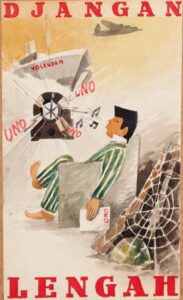Indonesia after Renville
This page is the eighth of nine in a virtual exhibition on Frank Porter Graham’s role in negotiations for the recognition of Indonesian independence. See the homepage for the exhibition here. See the previous page here. See the next page here.

The first few months following the Renville Agreement were a time of relative stability in Indonesia, with fewer armed clashes than in 1947. Vice-President Muhammad Hatta took on the additional role of Prime Minister of Indonesia and commanded a cross-party cabinet that committed itself to the diplomatic path toward independence. Days before his departure from Indonesia in January 1948, Dr. Frank wrote to his colleague the chancellor of North Carolina State College, saying
For the first time in eleven weeks, I have felt really free to relax. During these past eleven weeks, we have felt as though we were sitting on a volcano. But the truce agreement has now been signed and is being increasingly observed. The great principles [sic] of self-determination of peoples has been written into a fundamental agreement for a free and independent United States of Indonesia.[1]
Sadly, this did not last. In December 1948, less than a year after signing the Renville Agreement with the Committee of Good Offices, the Dutch unilaterally and flagrantly violated the treaty and made an unannounced attack on the capital of the Republic of Indonesia in Yogyakarta. In this swift move, the Dutch captured almost all of the nascent government, then held these leaders in a detention site on another island. This Dutch “Police Action” (more accurately called an “Aggression” by the Indonesian side) was a turning point not just for global diplomatic opinion and American policy, but for Dr. Frank personally. As he wrote to a Dutch diplomat in 1949,
When the Renville Agreement was broken, it almost put me in bed.[2]
At this point, the UN Security Council intervened strongly to force the Dutch to the negotiating table and to demand the release of the Indonesian leaders. Within months, Indonesia and the Netherlands were engaged in new rounds of talks (first leading to the Roem-van Royen agreement, then the Round Table Conference), which laid out a plan for the full transfer of sovereignty to a United States of Indonesia in December 1949. The basis of later negotiations remained the Renville Agreement negotiated by the Committee of Good Offices. Dr. Frank wrote to a colleague at the Department of State on November 10, 1949, saying
I am glad that the Renville Principles were included in the settlement. I think the over-all settlement as worked out is most valuable and hopeful at this time.[3]
The Netherlands formally recognized the sovereignty of the United States of Indonesia on December 27, 1949. President Sukarno and Vice-President Hatta, who had led the Republic of Indonesia since its proclamation of independence in August 1945, became the president and vice-president of the new United States of Indonesia, and the Republic of Indonesia was one of the constituent states—alongside many small states set up by the Dutch during the Revolution. Over the course of 1950, the political elite and the populace in each of these smaller states demanded full unification with the Republic, which had been the vehicle for Indonesian independence aspirations for years. One-by-one, the small states dissolved themselves into the Republic of Indonesia, so that by August 17, 1950—five years after the proclamation of Indonesian independence—only the Republic remained and the United States of Indonesia was no more.
[1] Letter from Frank Porter Graham to J.W. Harrellson, January 27, 1948, in Frank Porter Graham Papers, Wilson Library, UNC, box 2092.
[2] Letter from Frank P. Graham to Major William M. Vandeveur, May 30, 1949, in Frank Porter Graham Papers, Wilson Library, UNC, box 2157a.
[3] Letter from Frank P. Graham to F. E. Nolting, Jr., November 10, 1949, in Frank Porter Graham Papers, Wilson Library, UNC, box 2156b.
Further Reading:
This period in the Indonesian Revolution is well-covered in general histories of the Revolution, outlined in the further reading on a previous page of this exhibit.
Related to how difficult it was for the Indonesian military to accept the sacrifices made in the Renville Agreement and accept the new armistice line, the famous Indonesian general Abdul Haris Nasution wrote a history of the Indonesian Revolution with a whole volume dedicated to the Renville period (volume 7). A recent study of the international context for the diplomatic negotiations has been written (in Dutch) by Jeroen Kemperman, Emma Keizer, and Tom van Berge.
